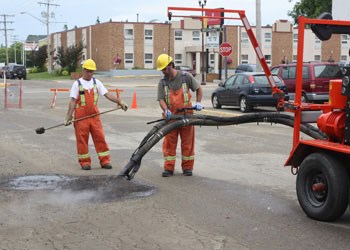Everyone in Yorkton knows about potholes, and the city is looking at new ways to combat the problem. The city has taken on a trial of the Dura-Patch pothole repair system, and is encouraged by the results.
Dura-Patch is a spray injection process. Using a specialized machine, it mixes aggregate and a heated asphalt emulsion, which is sprayed into the pothole. This allows it to be used in holes of varying sizes and depths. The steps of the process involve blowing water and debris from the pothole before applying a tack coat of asphalt emulsion to the sides and bottom of the pothole. Then, the pothole has the mix of emulsion and aggregate sprayed into it, and a layer of uncoated aggregate is used to cover the hole. Once the process is complete, the road can be opened immediately.
The city currently uses a cold patch system. The way it works is the hole is filled with a cold mix material, which is then compacted using the tires of the maintenance truck. This method has a number of disadvantages, chief among them is durability. Trent Mandzuk, Director of Public Works, says that the current system means that city workers frequently visit the same spot, something he believes will be changed by the new setup.
"With traditional pothole patching, we have to revisit the same deficiency sometimes three or four times a year. With this method, the road repair is actually a more permanent solution, and it can last up to two years. It saves us from going back," Mandzuk says.
"We tried it out on highway 9, where it's subject to heavy truck traffic, and it's standing up really well."
As well as promising a longer life for repairs, the Dura-Patch system is estimated to halve the operating costs, he says. He notes that the current system costs the city around $1,800 to $2,000 a day to operate, while the Dura-Patch system costs about $1,000 a day. The machine itself will cost about $70,000, but it will pay for itself through reduced operating costs, Mandzuk adds.
The city hasn't bought the system yet, but Mandzuk says that council has had a chance to view the process and the results, and he's confident that they will approve it for the 2013 operating budget.
Mayor James Wilson says that council has been watching the test carefully, and is pleased with the results they have seen over the two months the city has been using the machine. He says that it's going to be an investment in the future, particularly since the more permanent nature of the repair means that city crews won't have to repeatedly visit the same trouble areas.




